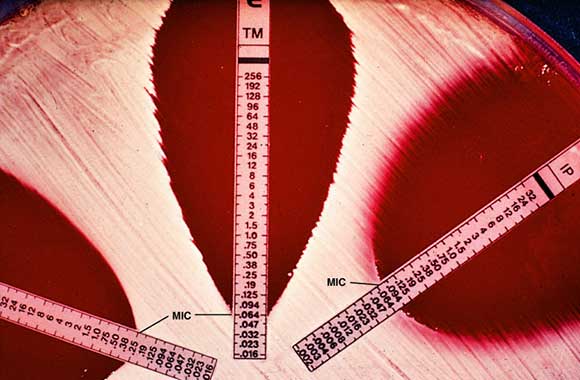E (Epsilometer) Test- Principle, Purpose, Procedure, Result Interpretation with Precaution, Advantages and Disadvantages
E (Epsilometer) Test- Principle, Purpose, Procedure, Result Interpretation with Precaution, Advantages and Disadvantages
The E-test has been developed to provide a direct quantification of antimicrobial susceptibility of microorganisms. E-test is a laboratory test used to determine minimum inhibitory concentration (MIC) and whether or not a specific strain of bacterium or fungus is susceptible to the action of a specific antibiotic. The principle of E test was first described in 1988 and was introduced commercially in 1991 by AB BIODISK.

E test strip is a non-porous plastic strip immobilized with predefined continuous and stable gradient of 15 antibiotic concentrations on one side and printed with an MIC scale on the other side of nylon strips.
E-test has an extensive range of over 100 antimicrobial references that can be classed into 4 categories:
- Antibiotics
- Antifungal
- Anti-mycobacterial
- Resistance phenotype testing
Principle of E-Test
E test is a quantitative technique that is based on combination of concept of both dilution and diffusion principle for susceptibility testing. E test strip is placed on to an inoculated agar plate; there is an immediate release of antibiotics from the plastic carrier surface into the agar surface. After incubation, bacterial growth becomes visible, symmetrical inhibition ellipse along the strip is seen. The MIC value is read from the scale in terms of µg/ml where the ellipse edge intersects the strip.
Purpose of E-Test
- Determine the MIC of fastidious, slow-growing or nutritionally deficient micro-organisms, or for a specific type of patient or infection.
- Detect low levels of resistance.
- Confirm/ detect a specific antimicrobial resistance phenotype such as ESBL, MBL, and AmpC.
- Confirm an equivocal Antimicrobial Susceptibility Test result.
- Test an antimicrobial not performed in routine use or a new, recently introduced antimicrobial agent.
Procedure of E-Test
- Remove the E-test package from the freezer (-20°C) and kept at room temperature at least 30 minutes before the test performed.
- Emulsify several well-isolated test strain colonies from an overnight agar plate in saline.
- Vortex for 15 second.
- Adjust the suspension turbidity to 0.5 McFarland standards. For mucoid organisms, adjust suspension to 1 McFarland standard.
(NOTE: Add more colonies to increase the turbidity or more saline to decrease the turbidity). - Soak a sterile cotton swab into the inoculum suspension and remove the excess fluid by pressing it against the inside wall of the test tube.
- Streak the swab over the entire agar surface in 3 directions by rotating the plate 60⁰ on Mueller Hinton Agar (MHA).
(NOTE: For Haemophilus species use Haemophilus Test Medium Agar (HTM) and for S. pneumonia and viridians streptococci use Mueller Hinton Blood Agar (MHBA)). - Allow the plate to dry for 5-15 minutes so that the surface is completely dry before applying E test gradient strip.
- Place the E test strip on agar plate with MIC scale facing upward and the concentration maximum nearest the rim of the plate.
- Incubate the plate as follows:
-
- Haemophilus species- CO2, 35ºC for 18 hours
- Streptococcus pneumoniae– CO2, 35ºC for 20-24 hours
- Staphylococcus aureus and Enterococcus species for Methicilllin and Vancomycin- O2, 35ºC for 24 hours
- Others- O2, 35ºC for 24 hours.
- After incubation observe zone of inhibition.
(NOTE: Four to six (maximum) E test strips can be placed on a 150 mm agar plate. For single MICs, one or two strips can be used on a 90 mm agar plate).
Result interpretation of E-Test
- Read the MIC value at the point where ellipse intersects the scale/E-test strip.
(NOTE: Do not read the plate if the culture appears mixed or if the lawn of growth is too light or too heavy). - If the MIC value between the standard two-fold dilution is seen, always round up to the highest value.
- Read the MIC value at complete inhibition of all growth including isolated colonies.
- If the intersect differs on either side of the strip, read the MIC as the greater value. Ignore any growth at the edge of the strip.
- Interpret E-test MIC results as Susceptible, Intermediate or Resistant.
Precaution of E-Test
- Aseptic procedures and precautions against microbiological hazards should be used when handling bacterial specimens.
- E-test should be used strictly according to the procedures described.
- Although based on a simple procedure, E-test should only be used by trained personnel.
- Read results only if a good inhibition ellipse is visible.
Advantages of E-Test
- Easy to perform and requires minimal training for test performance, however, end points can be difficult to determine for the azoles against Candida
- Contamination can be easily recognized.
- Can be easily set up for a small number of clinical isolates.
- Adequate method to detect potentially resistant strains to Amphotericin B.
Limitation of E-Test
- E-test is not suitable for Cryptococcus neoformans.

Please update me on news letter reltaed to microbiology
The Importance of E-Test is signified in this article.
Thank you for letting us know what ‘E’ stands for. Plenty of people use the test but very very very few know what 3 stands for.
Thank you so much for this article. It was very informative, indeed.